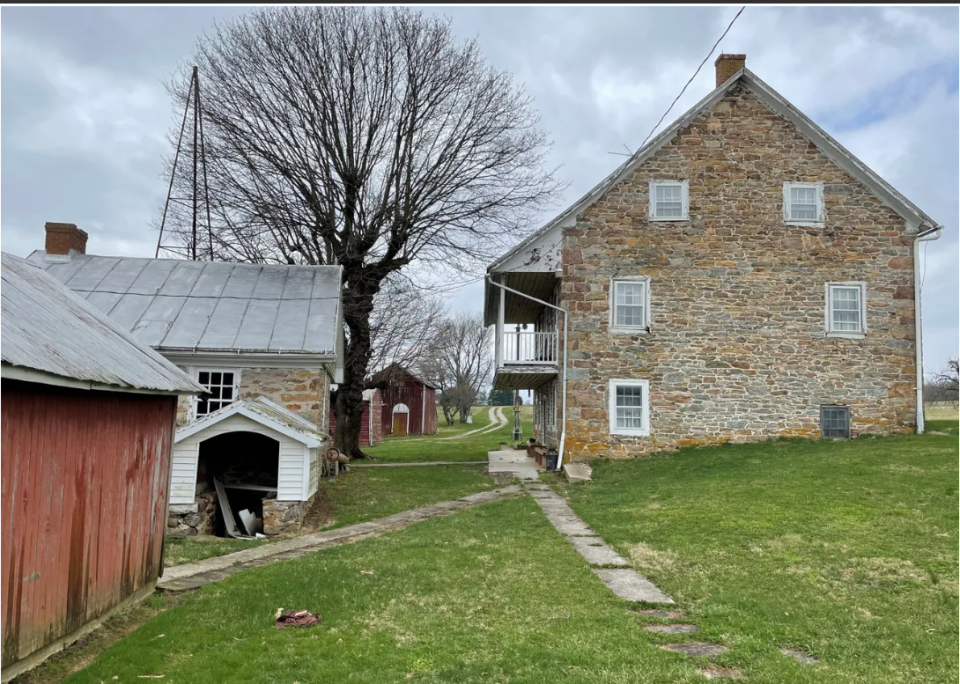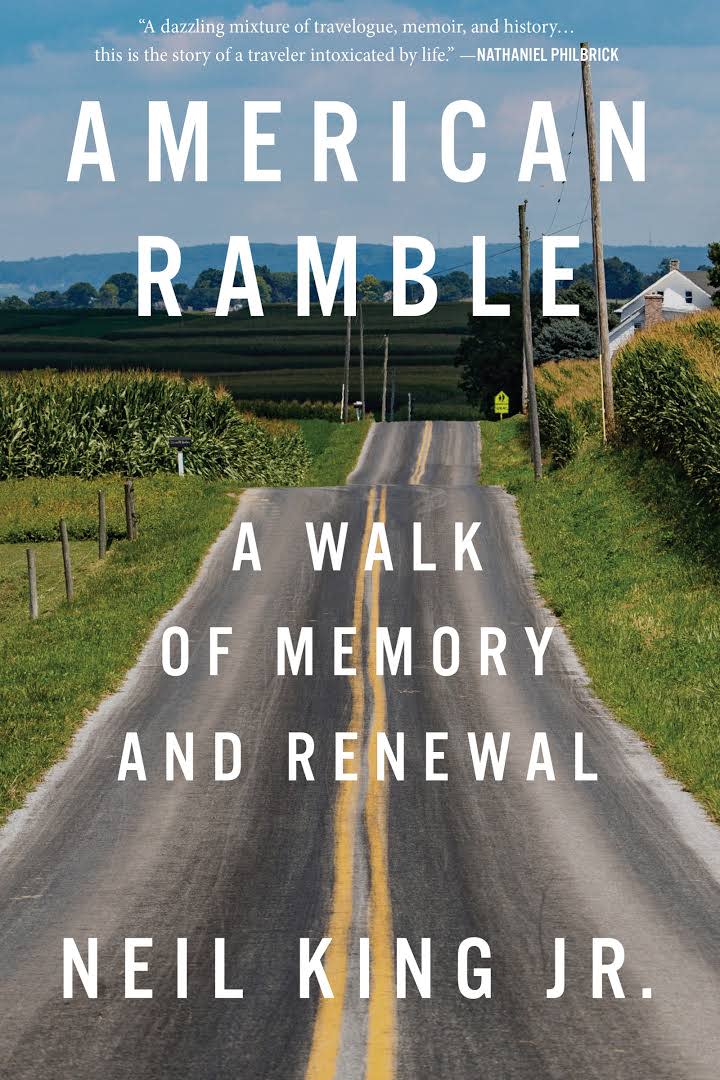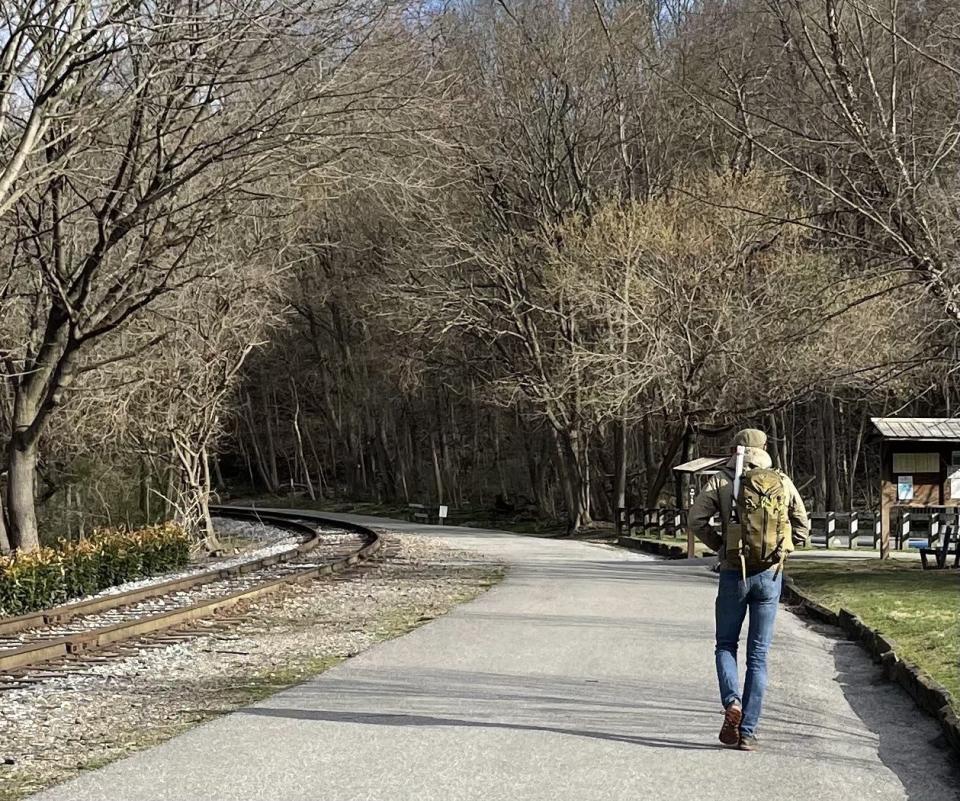Strolling writer takes in York County and the region at 3 miles an hour
When Neil King Jr. took his slow stroll through the fast Eastern Seaboard corridor, the rambling journalist paused on a farm straddling the Mason-Dixon Line.
The line that divided North and Pennsylvania and South and Maryland also separated the farmhouse from two barns.
The pre-Civil War house stood in the North, near New Freedom, and faced south. Its two barns sat in the South.
You could imagine in antebellum days, he wrote to those following his 330-mile walk from Washington, D.C., to New York City, the farmer and his wife standing on the farmhouse’s balcony looking into the South. They gazed from the part of the country where all people were free into the section where Black people were enslaved.
Those are the types of stories that this former Wall Street Journal reporter reflected on in his springtime walk in 2021 and then put to paper in his new book, “American Ramble: A Walk of Memory and Renewal.” As he journeyed for about a month, he explored places with history, conversed with residents and pondered his discoveries in his bid to make sense of an outside-the-beltway America.
After his survey of the farm hugging the Line, King traveled along the York County Heritage Rail Trail to York. He gathered enough stories to fill many pages about the county and the Susquehanna River region.

‘Memory boom’ in York
King’s reflections on the farmstead - whose owner likely pays taxes in two states - have relevance today.
In his book, he writes about Samantha Dorm and the Friends of Lebanon Cemetery’s restoration work on the historically Black cemetery in North York.
Interestingly, earlier this month, Dorm posted a Facebook story that reaches across the Mason-Dixon Line. It’s based on a 1941 obituary for William Jimerson of York’s Oak Lane. The 100-year-old was born enslaved near northern Maryland’s Jarrettsville.
At about the same time that Jimerson was born in bondage in 1841, a baby was delivered to a Black mother 15 miles away in Woodbine, York County, according to some records. John Aquilla Wilson was born free and fought with the U.S. Colored Troops in the Civil War. He died one year after Jimerson at the reported age of 101.
Slavery was phased out in Pennsylvania after 1780, and Wilson escaped slavery. It took the bloody Civil War to finally free Jimerson in 1865 in Maryland.
About 1890, Jimerson made his way across the Mason-Dixon Line to live out his days in York. The Friends posting on Facebook brought a response from a reader: “I think he was my grandmother's grandfather, but not sure, checking with my sisters.”

More:Taking in York County, a founding slice of America
More:Watch: Northern Central Railway visits York County trail towns in FestivICE excursion
A forgotten person is now remembered, though his burial stone has not yet been found in Lebanon, where he was interred.
In a recent interview, King highlighted this ongoing and public search for meaning in York County, as exemplified at Lebanon Cemetery. It’s something he calls a “memory boom,” a quest for better understanding York County’s past with the goal of creating “a wiser and more inclusive path forward.”
Interestingly, at least two other examples of this search for meaning and memory emerged the same week in York County as William Jimerson’s obituary surfaced.
The Codorus Valley Area Historical Society hosted a show-and-tell evening, a time for residents to share stories about people, family artifacts and their towns.
At one point, Eugene Myers stood holding a hat marked H&B Trucking in Jefferson. It was his father’s hat, and he went on to tell how his dad, Harry, died in a truck crash in New Jersey. He died just doing his job: delivering eggs.
Someone commented on the Facebook post bearing a picture of Eugene Myers with the hat: “I remember hearing this story from family and Gene personally.”
“Indeed, it was heartbreaking,” historical society President Tom Yingling replied.
A man who died in the line of duty remembered, and a community is strengthened.
In the interview, King also pointed out how the river town of Wrightsville pulls together many elements of America’s past with its bridges, railroad tracks and remnants of a canal.
As York County was discovering William Jimerson and Eugene Myers was remembering his father, Historic Wrightsville brought in Civil War historian Scott Mingus to talk about a story of community bravery. Mingus told how invading Confederates crossed the Mason-Dixon Line and targeted the bridge spanning the Susquehanna and the railroad tracks it carried. And how Union forces oversaw the burning of the bridge stopping the Confederate soldiers’ eastward march in their tracks.
An audience of 140 filled Wrightsville United Methodist Church to hear Mingus tell the story. Its telling and retelling have shaped Wrightsville for years and will continue to do so.

Mason-Dixon Line beckons
King would like to return to York County — or northern Maryland if you veer to miss a rock — to linger along the Mason-Dixon Line.
“I would love to go back,” he said in the interview, “and walk more of that line and find other, similar farms and think more about what it meant for our country to have had that huge but invisible gap between two very different views on life and freedom.”
Here is my full interview with King, noting that he’ll talk about his ramble in a free public presentation at 5 p.m., April 11, at York College’s Center for Community Engagement:
Q. Could you give two or three things you hope your readers take away from “American Ramble”?
A. The main lesson I hope to convey is that there is a very different America out there for anyone willing to take it slow, truly pay attention, and let the land and the people tell the story. I call it America at 3 miles an hour.
We are devoured now by division and distraction, and they feed on one another. People are consumed by events in distant places that flash repeatedly on the evening news or on their Facebook feed. My aim was to cast all that aside and pay attention only to what I encountered along the way. Nothing can bind you to a place and reveal its hidden beauties and secrets like a long walk. For me, the walk was not a physical exercise but an exercise in belonging and in challenging my own assumptions. It was an exercise in paying respect to the land itself.
Q. With the passing of a couple of years since your walk, what are your thoughts about the past or present story of York County and the Susquehanna River region?
A. York County tells the whole of the country’s story — its Indigenous roots, its Colonial founding, its deep North/South divisions, its industrial boom and current struggles — and all of it in very visible, tangible ways. The look of its farms and the feel of its towns and villages is so strikingly different from what the walker finds across the river in Lancaster County, vivid proof of how the imprint of the earliest settlers lingers on everywhere for centuries. The hamlet of Wrightsville alone encapsulates so much of our past: the various bridges and remnants of bridges, some of the country’s oldest railroad tracks, the tracings of the old canal. So many stories if you stop to listen.
Q. You have said that York’s Mayor Michael Helfrich is the most striking person you met on your 330-mile walk. How so?
A. Mayor Helfrich is a free-spirited eccentric in the best of ways. Where else in America can you find a mayor who lives, quite literally, in the 18th century, deeply steeped in the teachings of Thomas Paine and in a stone house built in 1761, but also seized by all the complexities of governing a modern city?
He symbolized what I came to call “the memory boom” now underway in York — people like you and Samantha Dorm and so many others who are encouraging a deeper understanding of York’s past in the hope of creating a wiser and more inclusive path forward. That is so essential to the vitality of a place.
Q. Is there a memorable place in York County you’d like to again visit? Is there a place you’d like to visit but could not because of time during your walk or that you’ve learned about since?
A. I will always cherish the couple hours I spent walking along and exploring a section of the old Mason-Dixon Line, including an incredible 1830s farmhouse built by a German family that I found that straddled the border with Maryland. I would love to go back and walk more of that line and find other, similar farms and think more about what it meant for our country to have had that huge but invisible gap between two very different views on life and freedom.
Also, when I walked the rail trail up along Codorus Creek from Railroad to York, I had no time to stop and fish. I would like to remedy that next time I come that way. That winding stretch of the creek is so gorgeous and so promising.

Q. Is there anything else that you’d like to communicate to York County residents and to a wider audience about your time in the county?
A. One lesson the entire walk taught me is that places give back meaning commensurate to the meaning you bring to them yourself. If you immerse yourself in the history of a place — its geology, its geography and earliest settlements and its moments of triumph and tragedy — then the whole of the place comes to life as you walk through it. You bring meaning and it gives meaning back in return. Our country may still be young, but its story is still extraordinarily nuanced and complex and so deserving of close attention.
I would urge anyone to do even a small version of what I did, which is to pick a destination a day or two’s walk from your front door, study the history of the land in between and then walk it slowly and deliberately to see what you will find. There truly is another country and another world outside your door and outside the confines of your car if you take it slow and pay it proper respect.
I have driven, flown or taken a fast train hundreds of times between my house in Washington and New York City. But I never really knew that stretch of land and had an inkling for the magic it holds until I went and walked it over nearly a month. The experience completely changed my view of the country. Maybe just as important, it also changed me. That experience is there for any of us if you step out your front door in just the right way.
Go ramble!
Upcoming event
Neil King Jr., author of “American Ramble: A Walk of Memory and Renewal,” will discuss his book and impressions about his walk through York County at 5 p.m.., April 11, at York College’s Center for Community Engagement, 59 East Market Street, York. “An American Rambles through the Heart of York County” is open to the public free of charge and cosponsored by the center and Hometown History, a video/podcast series.
Jim McClure is a retired editor of the York Daily Record and has authored or co-authored nine books on York County history. Reach him at jimmcclure21@outlook.com.
This article originally appeared on York Daily Record: Strolling writer takes in York County, region at 3 miles an hour

